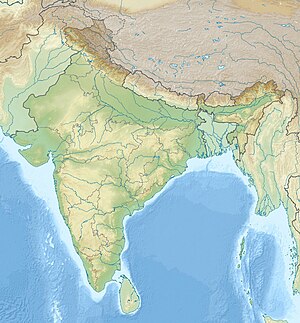Sāketa
Thank you for being part of the Bharatpedia family! 0% transparency: ₹0 raised out of ₹100,000 (0 supporter) |
Sāketa, in Sanskrit, a place where God resides. Saket can be alternatively used for Heaven or Vaikuntha in Hindu epics, where liberated souls dwell.[1] "Saketa", the name of the Ayodhya Kingdom was later widespread by Buddhist travellers and far away traders for the collective name of the region's under this Kingdom. Overall, according to early chronicles found in Hindi, Bengali, Gujarati, Marathi, Sanskrit literature and "Ramayana" and "Ramacharitamanas" the city bears name of Ayodhya Kingdom, not Sakēta.
In literature[edit]
Saket (1932), a famous Hindi epic poem by Maithili Sharan Gupt, a modern-version of Ramcharitmanas, which described an ideal Hindu society and Rama as an ideal man.[2][3] It is an account of the Ramayana through the eyes of Urmila, daughter of King Janaka of Mithila and the younger sister of Sita, who later became wife of Lakshmana.[citation needed]
In Buddhism[edit]
In Buddhism, the place is thought to be where the sons of Okkaka founded a city.[citation needed]
Ayodhya signifies a great importance in the Buddhist literature. It is referred to as Saket in traditional Buddhist literature. British archaeologist Alexander Cunningham who was also the first director general of the ASI identified three Buddhist places — Mani Parbat, Kuber Parbat and Sugriv Parbat at the site of Ayodhya.[citation needed]
See also[edit]
References[edit]
- ↑ Tulasīdāsa (1989). Gosvāmī Tulasīdāsakr̥ta Śrīrāmacaritamānasa. Motilal Banarsidass. pp. 892–. ISBN 978-81-208-0443-2. Retrieved 25 July 2013.
- ↑ Kuśa Satyendra (2000). Dictionary Of Hindu Literature. Sarup & Sons. pp. 71–. ISBN 978-81-7625-159-4. Retrieved 25 July 2013.
- ↑ Gilbert Pollet (1995). Indian Epic Values: Rāmāyaṇa and Its Impact : Proceedings of the 8th International Rāmāyaṇa Conference, Leuven, 6-8 July 1991. Peeters Publishers. pp. 198–. ISBN 978-90-6831-701-5. Retrieved 25 July 2013.


